The ongoing effort to minimize the rate and impact of fractures
/By Professor Celia Marr
In Thoroughbred racing, musculoskeletal injury is a major safety concern and is the leading reason for days lost to training. Musculoskeletal injury is the greatest reason for horse turnover in racing stables, with financial implications for the owner and the racing industry. Injuries, particularly on race day, have an impact on public perception of racing.
Upper limb and pelvis fractures are less common than lower limb fractures, but they can lead to fatalities. Reducing the overall prevalence of fractures is critical and, at the very least, improving the rate of detection of fractures in their early stages so the horse can be withdrawn from racing with a recoverable injury will be a big step forwards in racehorse welfare. Currently, we lack information on the outcomes following fracture, and an article recently published in the Equine Veterinary Journal (EVJ) from the veterinary team at the Hong Kong Jockey Club (HKJC) addressed this important knowledge gap.
Hong Kong Fracture Outcome Study
The HKJC veterinary team is in a unique position to carry out this work because their centralized and computerized database of clinical records, together with racing and retirement records, allows them to document follow-up, which is all but impossible elsewhere in the world. Dr. Leah McGlinchey, working with vets in Hong Kong and researchers from the Royal Veterinary College in London, reviewed clinical records from 2003 to 2014 to identify racehorses that suffered a fracture or fractures to the bones of the upper limb or the pelvis during training or racing, confirmed by nuclear scintigraphy, radiography, ultrasonography, or autopsy.
During these 11 racing seasons there were an average of 1468 horses in training each year, amounting to 102,785 starts over 8147 races, with 11% on dirt tracks and the rest on turf. McGlinchey found records of 108 racehorses that sustained 129 upper limb or pelvic fractures during 119 injury events. The most commonly fractured bone was the humerus at 50%, followed by the tibia at 30%. Nine horses sustained fractures that led to their immediate demise, five involving the scapula and four involving the humerus.
The majority (65%) of fractures occurred in training. The overall incidence of upper limb and pelvic fractures in Hong Kong was three per 10,000 starts, and there were very similar incidences comparing both turf and dirt surfaces. The fatality rate due to upper limb and pelvic fracture was 0.8 per 10,000 starts. Over comparable time periods, race day upper limb and pelvic fracture rates were four per 10,000 starts in the UK, while race day fatalities were 1.8 per 10,000 starts in the UK and 1.9 per 10,000 in California; thus, rates of upper limb and pelvic fracture and fatality were lower in Hong Kong than in other racing jurisdictions. Differences in training and racing regimens, racehorse surveillance, and veterinary care will vary across these racing centers, leading to different risk profiles for horses racing in these different locations.
This CT image taken during an autopsy, shows a comminuted fracture with multiple bone fragments.
All horses presented with lameness but importantly, the lameness grade was not necessarily very high. Indeed, 6.7% of the horses were Grade 1 of 5 lame, and 30.3% were Grade 2 of 5 lame, highlighting how important it is to rest and investigate mild new lameness. Typically, stress fractures cause acute lameness following fast work that soon eases in severity, and incipient fracture of the upper limb and pelvis can present as mild lameness with a subtle onset, which is all too easy to overlook. The degree of lameness associated with stress fracture is typically greatest when the scapula is involved and progressively less severe with the tibia, humerus, or radius. The diagnosis is all too obvious once severe, complete fracture has occurred. In many cases, however, a diagnosis cannot be immediately made. Nuclear scintigraphy (also known as bone scanning) is the most sensitive method to detect stress fractures of the long bones and pelvis, although radiography and ultrasonography may also be useful.
Following fracture, all of the Hong Kong horses had a period of box rest followed by handwalking only. Three-quarters of these horses returned to racing a median of 169 days after sustaining the fracture; these made numerous starts, and 45 won. In total, 59 horses had retired from training, 23 of which retired without returning to racing and, in 13 of these cases, with retirement directly attributable to the upper limb fracture.
TO READ MORE --
BUY THIS ISSUE IN PRINT OR DOWNLOAD -
August - October 2018, issue 49 (PRINT)
$5.95
August - October 2018, issue 49 (DOWNLOAD)
$3.99
Why not subscribe?
Don't miss out and subscribe to receive the next four issues!
Print & Online Subscription
$24.95





















